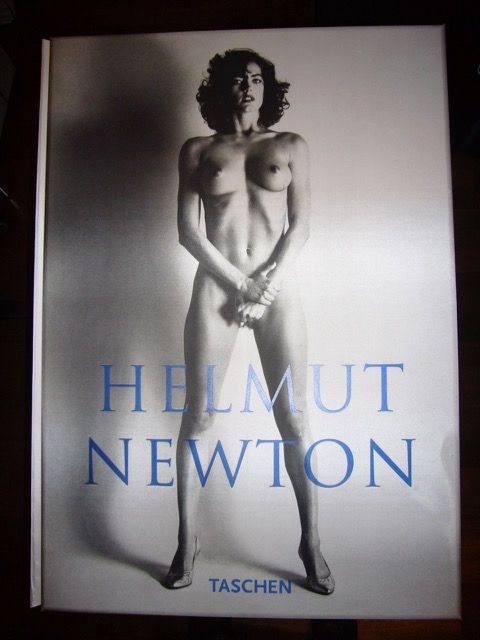Polaroids from the Piero Bisazza Collection Helmut Newton Follow Sylvia in my studio, Paris 1981 Unique Polaroid print. Image: 9.4 x 7.2 cm (3 3/4 x 2 7/8 in.) Sheet: 10.7 x 8.5 cm (4 1/4 x 3 3/8 in.) Signed in ink on the verso.
Provenance Acquired directly from the artist Private Collection, Miami Howard Greenberg Gallery, New York, 2005 Literature Z. Felix, ed., The Best of Helmut Newton , New York: Thunder's Mouth Press, 1996, pl. 63, variant M. Heiting, ed., Helmut Newton Work , Cologne: Taschen, 2000, p. 206, variant Helmut Newton Private Property , Munich: Schirmer/Mosel, 2003, pl. 31, variant Helmut Newton Big Nudes , Munich: Schirmer/Mosel, 2004, cover, variant Catalogue Essay 'It’s a wonderful sketchpad, the Polaroid. I use it often to take my "first look" at what I am about to do. Do I like what I see? Do I want to continue in this way or change my tactics? Somewhere along the line, and rather sooner than later, I must make a decision on how I want the sitting to go – in what direction. The pola helps me.’ Helmut Newton in Pola Woman , 1992 Helmut Newton and the Polaroid Helmut Newton started taking pictures with the Polaroid camera in the 1970s, using it to test lighting conditions and see instantly how a situation would appear photographically. After a day of shooting, he would come home and share his Polaroids with his wife June who would sometimes use them as place cards at dinner parties. In 1992 Newton decided to officially position these works within his oeuvre and published Pola Woman , a personal project that showcased his Polaroid prints. The Polaroids in the book were accompanied by Newton’s short captions about the shoot or the model, emphasising his intimate relationship to these images. Many of the Newton Polaroids found in the Piero Bisazza Collection are the actual prints reproduced in Pola Woman . Such examples in the sale include the cover of Pola Woman , Arielle for Amica, Milan (lot 8), Prunella and Sylvie on the Quai d'Orsay for Playboy (lot 152) and the first Polaroid in Pola Woman , Modelling Fashion for Vogue Hommes (lot 160). Polaroids of such quintessential Newton images as Bergström over Paris (lot 11) and Sylvia in My Studio (lot 159) are also featured. Together, these works offer a captivating insight into how ideas were formed in Newton’s restless imagination and reveal the eye of a master photographer. Please refer to lots 1– 11 for Polaroids from the Piero Bisazza Collection in the ULTIMATE Evening Sale. Read More Artist Bio Helmut Newton German • 1920 - 2004 Follow Helmut Newton's distinct style of eroticism and highly produced images was deemed rebellious and revolutionary in its time, as he turned the expected notion of beauty, depicted by passive and submissive women, on its head. Depicting his models as strong and powerful women, Newton reversed gender stereotypes and examined society's understanding of female desire. Newton created a working space for his models that was part decadent and part unorthodox — a safe microcosm in which fantasies became reality. And perhaps most famously of all, Newton engendered an environment in which his female models claimed the space around them with unapologetic poise and commanding sensuality. His almost cinematic compositions provided a hyper-real backdrop for the provocative images of sculptural, larger-than-life women, and enhanced the themes of voyeurism and fetishism that run throughout his work. View More Works
Polaroids from the Piero Bisazza Collection Helmut Newton Follow Sylvia in my studio, Paris 1981 Unique Polaroid print. Image: 9.4 x 7.2 cm (3 3/4 x 2 7/8 in.) Sheet: 10.7 x 8.5 cm (4 1/4 x 3 3/8 in.) Signed in ink on the verso.
Provenance Acquired directly from the artist Private Collection, Miami Howard Greenberg Gallery, New York, 2005 Literature Z. Felix, ed., The Best of Helmut Newton , New York: Thunder's Mouth Press, 1996, pl. 63, variant M. Heiting, ed., Helmut Newton Work , Cologne: Taschen, 2000, p. 206, variant Helmut Newton Private Property , Munich: Schirmer/Mosel, 2003, pl. 31, variant Helmut Newton Big Nudes , Munich: Schirmer/Mosel, 2004, cover, variant Catalogue Essay 'It’s a wonderful sketchpad, the Polaroid. I use it often to take my "first look" at what I am about to do. Do I like what I see? Do I want to continue in this way or change my tactics? Somewhere along the line, and rather sooner than later, I must make a decision on how I want the sitting to go – in what direction. The pola helps me.’ Helmut Newton in Pola Woman , 1992 Helmut Newton and the Polaroid Helmut Newton started taking pictures with the Polaroid camera in the 1970s, using it to test lighting conditions and see instantly how a situation would appear photographically. After a day of shooting, he would come home and share his Polaroids with his wife June who would sometimes use them as place cards at dinner parties. In 1992 Newton decided to officially position these works within his oeuvre and published Pola Woman , a personal project that showcased his Polaroid prints. The Polaroids in the book were accompanied by Newton’s short captions about the shoot or the model, emphasising his intimate relationship to these images. Many of the Newton Polaroids found in the Piero Bisazza Collection are the actual prints reproduced in Pola Woman . Such examples in the sale include the cover of Pola Woman , Arielle for Amica, Milan (lot 8), Prunella and Sylvie on the Quai d'Orsay for Playboy (lot 152) and the first Polaroid in Pola Woman , Modelling Fashion for Vogue Hommes (lot 160). Polaroids of such quintessential Newton images as Bergström over Paris (lot 11) and Sylvia in My Studio (lot 159) are also featured. Together, these works offer a captivating insight into how ideas were formed in Newton’s restless imagination and reveal the eye of a master photographer. Please refer to lots 1– 11 for Polaroids from the Piero Bisazza Collection in the ULTIMATE Evening Sale. Read More Artist Bio Helmut Newton German • 1920 - 2004 Follow Helmut Newton's distinct style of eroticism and highly produced images was deemed rebellious and revolutionary in its time, as he turned the expected notion of beauty, depicted by passive and submissive women, on its head. Depicting his models as strong and powerful women, Newton reversed gender stereotypes and examined society's understanding of female desire. Newton created a working space for his models that was part decadent and part unorthodox — a safe microcosm in which fantasies became reality. And perhaps most famously of all, Newton engendered an environment in which his female models claimed the space around them with unapologetic poise and commanding sensuality. His almost cinematic compositions provided a hyper-real backdrop for the provocative images of sculptural, larger-than-life women, and enhanced the themes of voyeurism and fetishism that run throughout his work. View More Works














Testen Sie LotSearch und seine Premium-Features 7 Tage - ohne Kosten!
Lassen Sie sich automatisch über neue Objekte in kommenden Auktionen benachrichtigen.
Suchauftrag anlegen